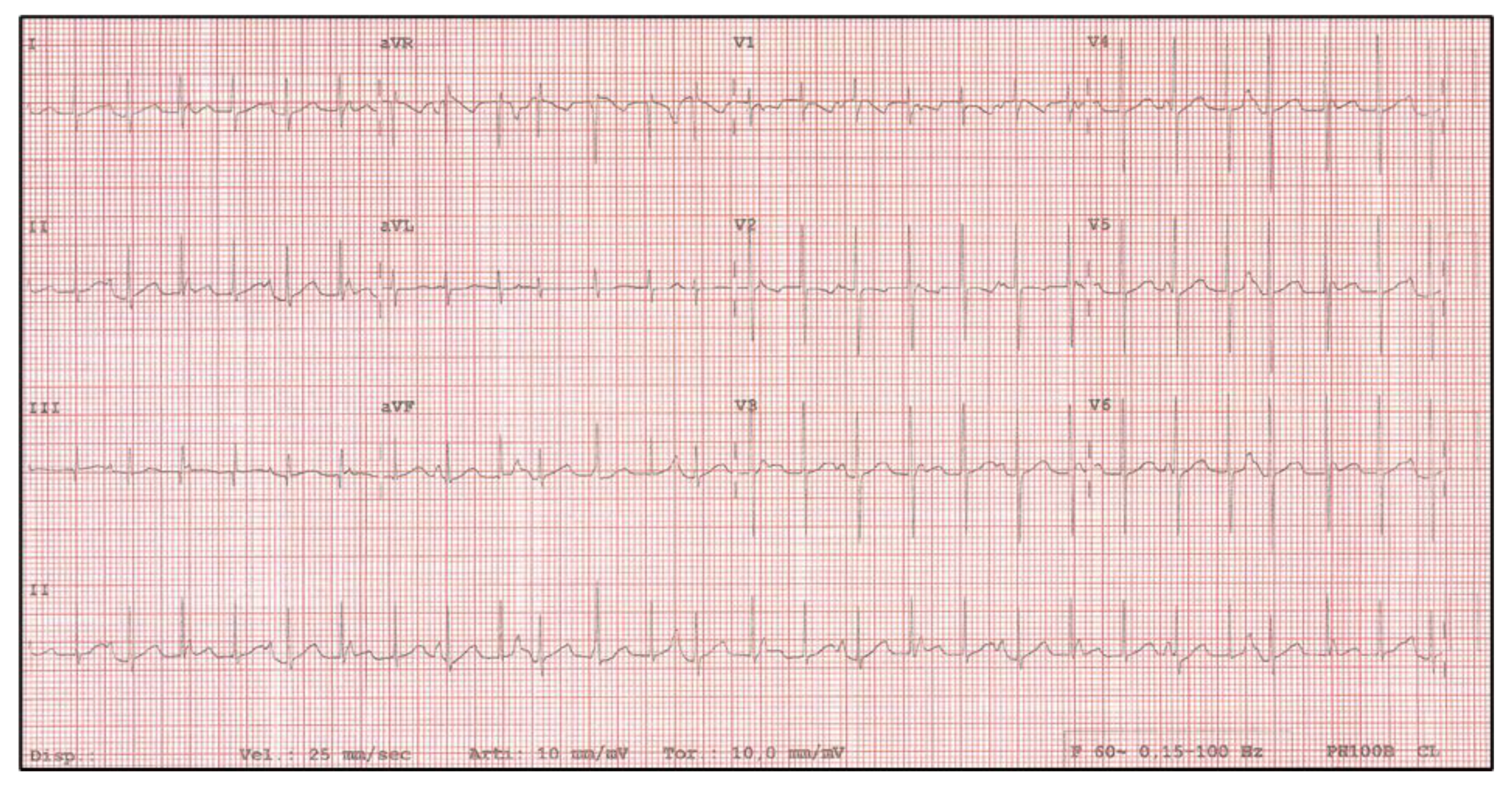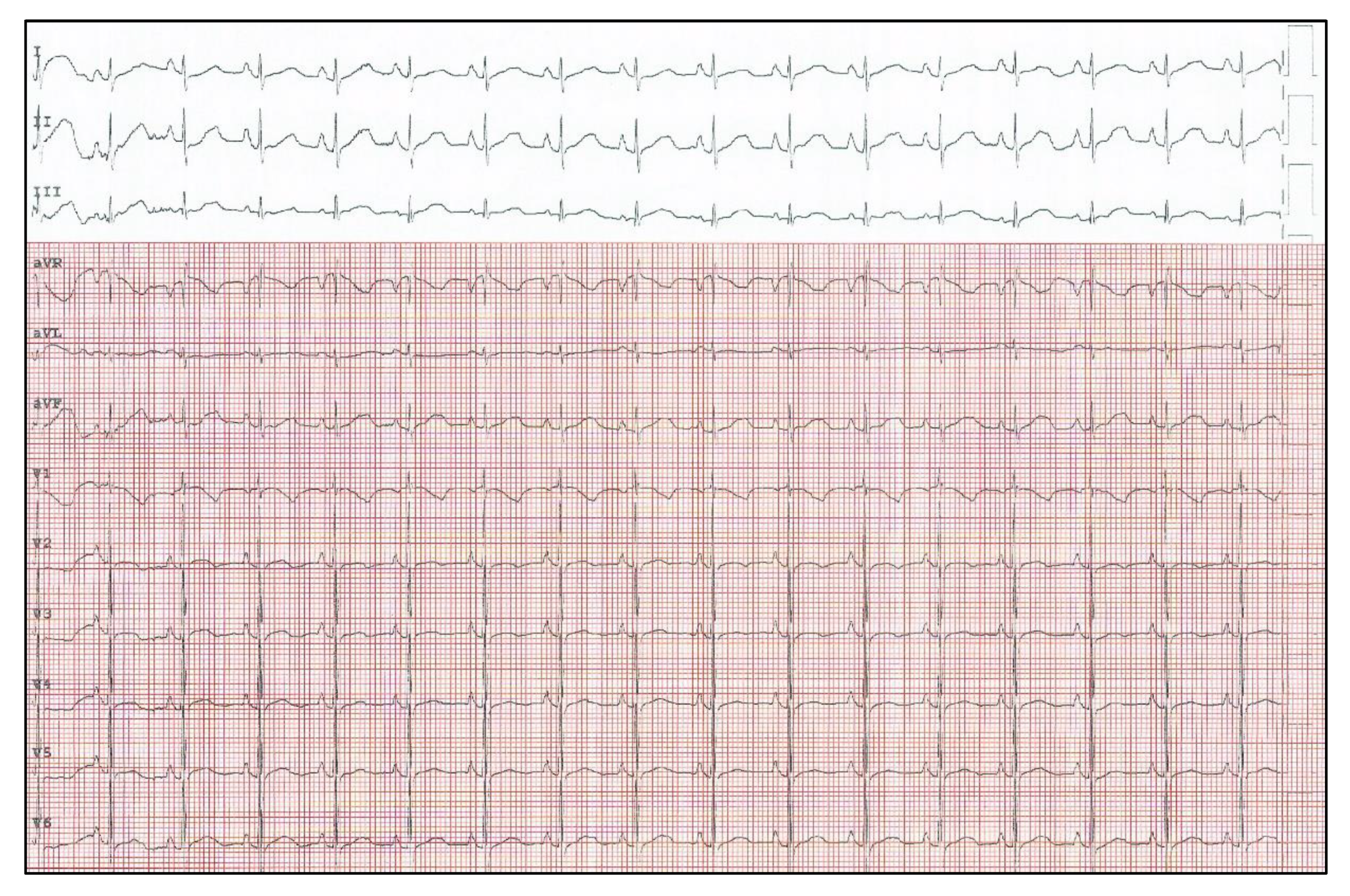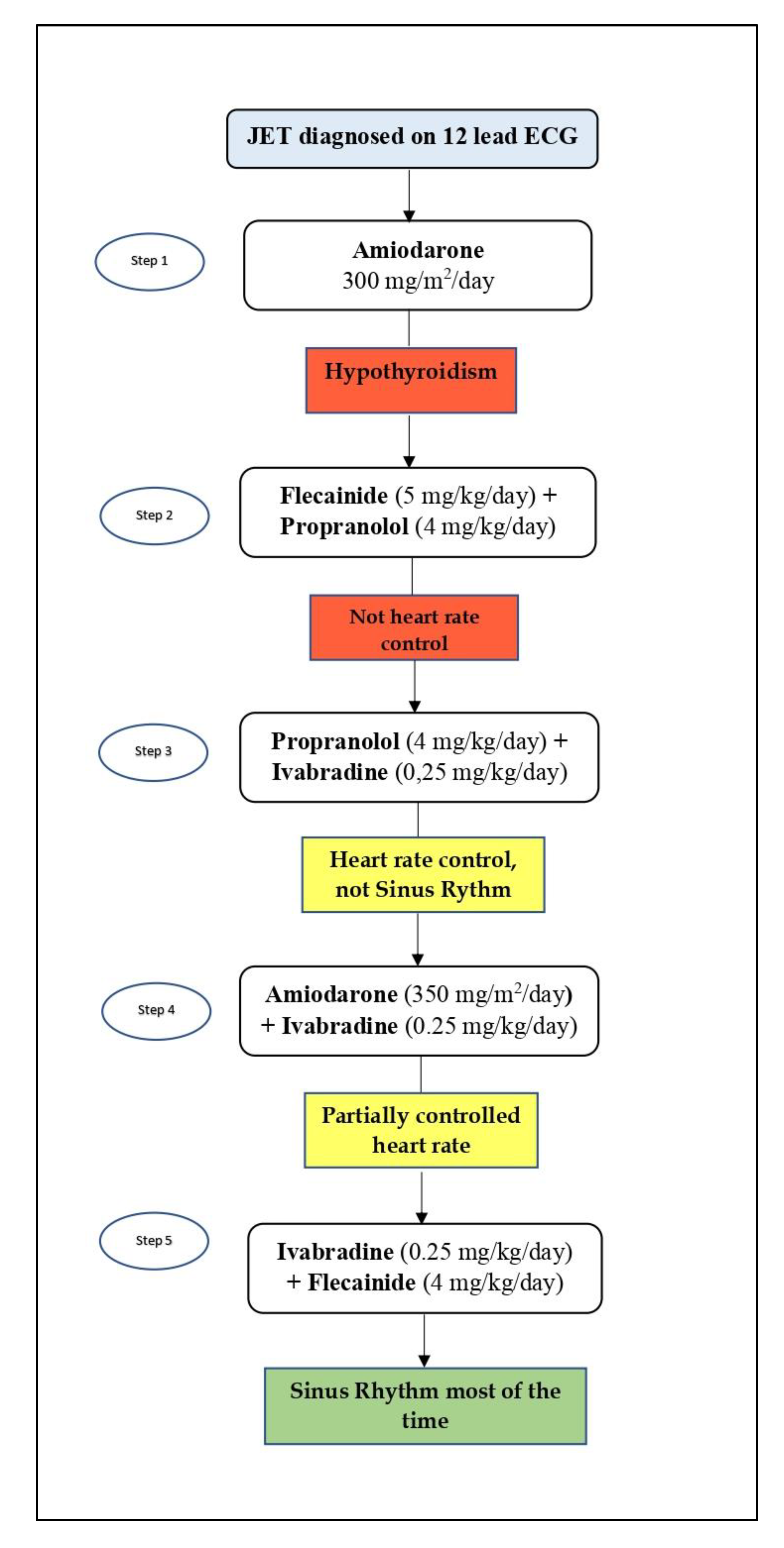Ivabradine–Flecainide as Breakthrough Drug Combination for Congenital Junctional Ectopic Tachycardia: A Case Report and Literature Review
Abstract
:1. Introduction
2. Case Report
3. Discussion
4. Conclusions
Author Contributions
Funding
Institutional Review Board Statement
Informed Consent Statement
Data Availability Statement
Conflicts of Interest
References
- Kylat, R.I.; Samson, R.A. Junctional ectopic tachycardia in infants and children. J. Arrhythm. 2020, 36, 59–66. [Google Scholar] [CrossRef] [PubMed]
- Collins, K.K.; Van Hare, G.F.; Kertesz, N.J.; Law, I.H.; Bar-Cohen, Y.; Dubin, A.M.; Etheridge, S.P.; Berul, C.I.; Avari, J.N.; Tuzcu, V.; et al. Pediatric nonpost-operative junctional ectopic tachycardia medical management and interventional therapies. J. Am. Coll. Cardiol. 2009, 53, 690–697. [Google Scholar] [CrossRef] [PubMed] [Green Version]
- Brugada, J.; Blom, N.; Sarquella-Brugada, G.; Blomstrom-Lundqvist, C.; Deanfield, J.; Janousek, J.; Abrams, D.; Bauersfeld, U.; Brugada, R.; Drago, F.; et al. Pharmacological and non-pharmacological therapy for arrhythmias in the pediatric population: EHRA and AEPC-Arrhythmia Working Group joint consensus statement. Europace 2013, 15, 1337–1382. [Google Scholar] [CrossRef] [PubMed]
- Siddoway, L.A. Amiodarone: Guidelines for use and monitoring. Am. Fam. Physician 2003, 68, 2189–2196. [Google Scholar]
- Saul, J.P.; Scott, W.A.; Brown, S.; Marantz, P.; Acevedo, V.; Etheridge, S.P.; Perry, J.C.; Triedman, J.K.; Burriss, S.W.; Cargo, P.; et al. Intravenous amiodarone for incessant tachyarrhythmias in children: A randomized, double-blind, antiarrhythmic drug trial. Circulation 2005, 112, 3470–3477. [Google Scholar] [CrossRef] [Green Version]
- Benjamín, M.N.; Infante, J.; Olmedo, J.; Abello, M.; Moltedo, J.M. Taquicardia ectópica congénita de la unión. Tratamiento farmacológico en el primer año de vida” [Congenital junctional ectopic tachycardia. Pharmacologic management during infancy]. Medicina 2011, 71, 521–524. [Google Scholar]
- Villain, E.; Vetter, V.L.; Garcia, J.M.; Herre, J.; Cifarelli, A.; Garson, A. Evolving concepts in the management of congenital junctional ectopic tachycardia. A multicenter study. Circulation 1990, 81, 1544–1549. [Google Scholar] [CrossRef] [Green Version]
- Sarubbi, B.; Musto, B.; Ducceschi, V.; D’Onofrio, A.; Cavallaro, C.; Vecchione, F.; Musto, C.; Calabrò, R. Congenital junctional ectopic tachycardia in children and adolescents: A 20 year experience based study. Heart 2002, 88, 188–190. [Google Scholar] [CrossRef] [Green Version]
- Fenrich, A.L.; Perry, J.C.; Friedman, R.A. Flecainide and amiodarone: Combined therapy for refractory tachyarrhythmias in infancy. J. Am. Coll Cardiol. 1995, 25, 1195–1198. [Google Scholar] [CrossRef] [Green Version]
- Imamura, T.; Tanaka, Y.; Ninomiya, Y.; Yoshinaga, M. Combination of flecainide and propranolol for congenital junctional ectopic tachycardia. Pediatr. Int. 2015, 57, 716–718. [Google Scholar] [CrossRef]
- DiFrancesco, D.; Camm, J.A. Heart rate lowering by specific and selective I(f) current inhibition with ivabradine: A new therapeutic perspective in cardiovascular disease. Drugs 2004, 64, 1757–1765. [Google Scholar] [CrossRef] [PubMed]
- Andrikopoulos, G.; Dasopoulou, C.; Sakellariou, D.; Tzeis, S.; Koulouris, S.; Kranidis, A.; Kappos, K.; Manolis, A.S. Ivabradine: A selective If current inhibitor in the treatment of stable angina. Recent Pat. Cardiovasc. Drug Discov. 2006, 1, 277–282. [Google Scholar] [CrossRef]
- Guglin, M. Heart rate reduction in heart failure: Ivabradine or beta blockers? Heart Fail. Rev. 2013, 18, 517–528. [Google Scholar] [CrossRef] [PubMed]
- Al-Ghamdi, S.; Al-Fayyadh, M.I.; Hamilton, R.M. Potential new indication for ivabradine: Treatment of a patient with congenital junctional ectopic tachycardia. J. Cardiovasc. Electrophysiol. 2013, 24, 822–824. [Google Scholar] [CrossRef]
- Kothari, S.S.; Kidambi, B.R.; Juneja, R. Ivabradine for congenital junctional ectopic tachycardia in siblings. Ann. Pediatr. Cardiol. 2018, 11, 226–228. [Google Scholar] [CrossRef]
- Ergul, Y.; Ozturk, E.; Ozgur, S.; Ozyurt, A.; Cilsal, E.; Guzeltas, A. Ivabradine is an effective antiarrhythmic therapy for congenital junctional ectopic tachycardia-induced cardiomyopathy during infancy: Case studies. Pacing Clin. Electrophysiol. 2018, 41, 1372–1377. [Google Scholar] [CrossRef]
- Horsthuis, T.; Buermans, H.P.; Brons, J.F.; Verkerk, A.O.; Bakker, M.L.; Wakker, V.; Clout, D.E.; Moorman, A.F.; ’t Hoen, P.A.; Christoffels, V.M. Gene expression profiling of the forming atrioventricular node using a novel tbx3-based node-specific transgenic reporter. Circ. Res. 2009, 105, 61–69. [Google Scholar] [CrossRef] [Green Version]
- Dieks, J.K.; Klehs, S.; Müller, M.J.; Paul, T.; Krause, U. Adjunctive ivabradine in combination with amiodarone: A novel therapy for pediatric congenital junctional ectopic tachycardia. Heart Rhythm. 2016, 13, 1297–1302. [Google Scholar] [CrossRef]
- Ríos, M.; Chiesa, P.; Arhcilles, S.; Cuesta, A.; Moltedo, J.M. Uso de la ivrabadina para el tratamiento de la taquicardia ectópica de la unión congénita [Use of ivabradine for the treatment of congenital junctional ectopic tachycardia]. Medicina 2021, 81, 293–296. [Google Scholar] [PubMed]
- Khan, N.; Salvi, P.; Dharod, D.; Chokhandre, M.; Mandrekar, A.; Joshi, S. Use of Ivabradine in the Treatment of Tachyarrhythmias After Surgery for Congenital Heart Diseases. J. Cardiothorac. Vasc. Anesth. 2020, 34, 2395–2400. [Google Scholar] [CrossRef]
- Krishna, M.R.; Kunde, M.F.; Kumar, R.K.; Balaji, S. Ivabradine in Post-operative Junctional Ectopic Tachycardia (JET): Breaking New Ground. Pediatr. Cardiol. 2019, 40, 1284–1288. [Google Scholar] [CrossRef]
- Kumar, V.; Kumar, G.; Joshi, S.; Sharma, V. Ivabradine for junctional ectopic tachycardia in post congenital heart surgery. Indian Heart J. 2017, 69, 666–667. [Google Scholar] [CrossRef] [PubMed]
- Kumar, V.; Kumar, G.; Tiwari, N.; Joshi, S.; Sharma, V.; Ramamurthy, R. Ivabradine as an Adjunct for Refractory Junctional Ectopic Tachycardia Following Pediatric Cardiac Surgery: A Preliminary Study. World J. Pediatr. Congenit. Heart Surg. 2019, 10, 709–714. [Google Scholar] [CrossRef] [PubMed]
- Sahu, M.; Niraghatam, H.; Bansal, N.; Singh, S.; Rajashekar, P.; Choudhary, S. Ivabradine—The Final Crusader for Postoperative Junctional Ectopic Tachycardia, a Case Report with Literature Review. World J. Cardiovasc. Surg. 2019, 9, 73–82. [Google Scholar] [CrossRef] [Green Version]
- Sharma, D.; Subramaniam, G.; Sharma, N. Use of ivabradine for treatment of junctional ectopic tachycardia in post congenital heart surgery. Indian J. Thorac. Cardiovasc. Surg. 2021, 37, 323–325. [Google Scholar] [CrossRef] [PubMed]



| Author | Number of Patients (N); Gender | Antiarrhythmic Medication Before Ivabradine | Treatment with Ivabradine (Dose) | Outcome, Response to Ivabradine | Antiarrhythmic Medication with Ivabradine | Adverse Reactions | |
|---|---|---|---|---|---|---|---|
| Congenital JET | Al-Ghamdi et al. [14] | N = 1; F | Flecainide, sotalol, procainamide, amiodarone | 2.5 mg once daily | SR, HR control | None | None |
| Dieks et al. [18] | N = 5; 2 M, 3 F | Amiodarone, n = 5 Flecainide, n = 1 Digoxin, n =2 | 0.05–0.1 mg/kg increased up to 0.28 mg/kg/d | HR control, n = 5 SR, n = 3 JR/JET, n = 1 JR/SR, n = 1 | Amiodarone, n = 5 Propranolol, amiodarone, n = 2 Digoxin, amiodarone, flecainide, n = 1 | None | |
| Ergul et al. [16] | N = 3; 2 M, 1 F | Flecainide, amiodarone, digoxin, n = 1 Flecainide, amiodarone, propranolol, n = 2 | 0.1 mg/kg/d | HR control, n = 3 SR, n = 2 JR/SR, n = 1 | Amiodarone, n = 1 Amiodarone, propranolol, flecainide, n = 2 | None | |
| Kothari et al. [15] | N = 2; 1 M, 1 F | Amiodarone, propranolol, flecainide, n = 2 | 0.5 mg/kg/dose | SR, HR control | Amiodarone, propranolol, flecainide, n = 2 | None | |
| Rios et al. [19] | N = 2; 2 M | Amiodarone, flecainide, propranolol, n = 1 Propranolol, amiodarone, n = 1 | 0.05/mg/kg/dose | HR control, n = 2 SR/TN, n = 2 | Amiodarone, n = 2 | None | |
| Postoperative JET | Khan et al. [20] | N = 7 (6 Jet); 5 M, 2 F | Amiodarone, n = 7 | 0.05 mg/kg/dose | SR, n = 4 HR control with persistent slow JET, n = 1 | Amiodarone | None |
| Krishna et al. [21] | N = 8; 4 M, 4 F | Amiodarone, n = 1 Overdrive pacing, n = 5 | 0.05 mg/kg/dose twice daily | SR, HR control, n = 8 | Amiodarone, n = 1 | Bradycardia | |
| Kumar et al. [22] | N = 2; 1 M, 1 F | Amiodarone, esmolol, n = 1 | 0.1 mg/kg/d | SR, n = 2 | It is not clear whether ivabradine was used as a single or adjunctive treatment | N/S | |
| Kumar * et al. [23] | N = 5; 3 M, 2 F | Amiodaron, esmolol, n = 5 | 0.1–0.2 mg/kg/d twice daily | SR, HR control, n = 5 | Amiodarone, n = 2 | None | |
| Sahu et al. [24] | N = 1; F | Magnesium sulfate, digoxin, amiodaron | 0.05 mg/kg twice daily | SR, HR control | None | None | |
| Sharma et al. [25] | N = 4; 2 M, 2 F | Magnesium, n = 4 | 0.1–0.2 mg/kg/dose | SR, HR control, n = 4 | None | Bradycardia |
Publisher’s Note: MDPI stays neutral with regard to jurisdictional claims in published maps and institutional affiliations. |
© 2021 by the authors. Licensee MDPI, Basel, Switzerland. This article is an open access article distributed under the terms and conditions of the Creative Commons Attribution (CC BY) license (https://creativecommons.org/licenses/by/4.0/).
Share and Cite
Di Marco, G.M.; De Nigris, A.; Pepe, A.; Pagano, A.; Di Nardo, G.; Tipo, V. Ivabradine–Flecainide as Breakthrough Drug Combination for Congenital Junctional Ectopic Tachycardia: A Case Report and Literature Review. Pediatr. Rep. 2021, 13, 624-631. https://doi.org/10.3390/pediatric13040074
Di Marco GM, De Nigris A, Pepe A, Pagano A, Di Nardo G, Tipo V. Ivabradine–Flecainide as Breakthrough Drug Combination for Congenital Junctional Ectopic Tachycardia: A Case Report and Literature Review. Pediatric Reports. 2021; 13(4):624-631. https://doi.org/10.3390/pediatric13040074
Chicago/Turabian StyleDi Marco, Giovanni Maria, Angelica De Nigris, Angela Pepe, Annamaria Pagano, Giangiacomo Di Nardo, and Vincenzo Tipo. 2021. "Ivabradine–Flecainide as Breakthrough Drug Combination for Congenital Junctional Ectopic Tachycardia: A Case Report and Literature Review" Pediatric Reports 13, no. 4: 624-631. https://doi.org/10.3390/pediatric13040074
APA StyleDi Marco, G. M., De Nigris, A., Pepe, A., Pagano, A., Di Nardo, G., & Tipo, V. (2021). Ivabradine–Flecainide as Breakthrough Drug Combination for Congenital Junctional Ectopic Tachycardia: A Case Report and Literature Review. Pediatric Reports, 13(4), 624-631. https://doi.org/10.3390/pediatric13040074






